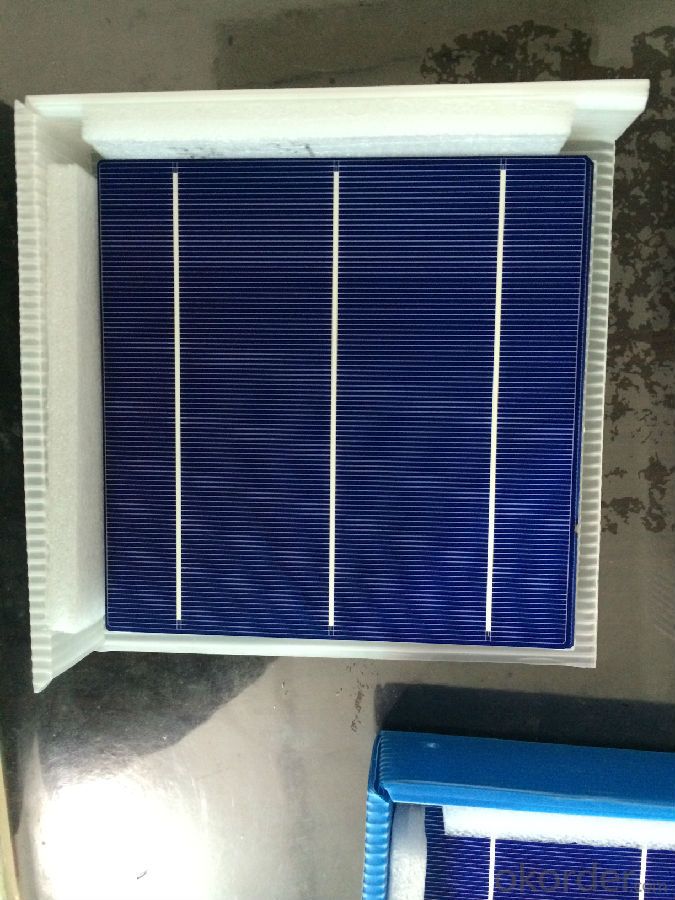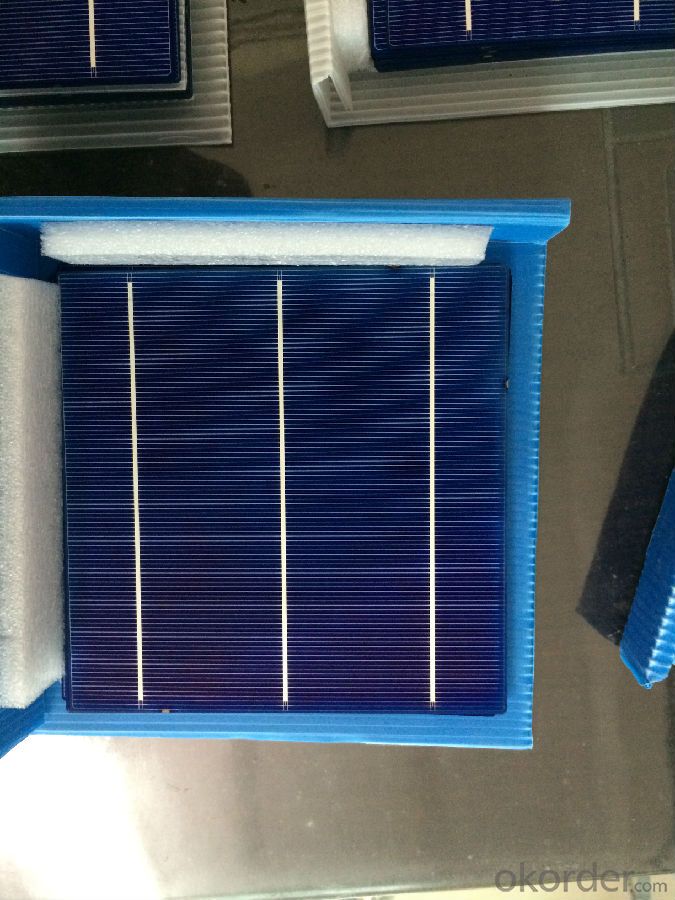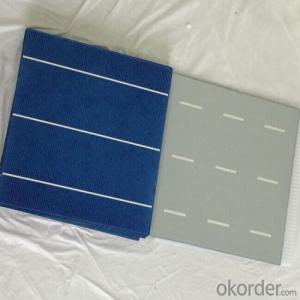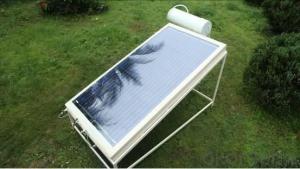Poly Solar Cells 156*156mm B Grade Low Price
- Loading Port:
- Shanghai
- Payment Terms:
- TT or LC
- Min Order Qty:
- 30000 pc
- Supply Capability:
- 1000000 pc/month
OKorder Service Pledge
OKorder Financial Service
You Might Also Like
Product description
Poly Solar Cells 156*156mm B Grade Low Price
A solar cell, or photovoltaic cell, is an electrical device that converts the energy of light directly into electricity by the photovoltaic effect, which is a physical and chemical phenomenon.[1] It is a form of photoelectric cell, defined as a device whose electrical characteristics, such as current, voltage, or resistance, vary when exposed to light. Solar cells are the building blocks of photovoltaic modules, otherwise known as solar panels.
Solar cells are described as being photovoltaic irrespective of whether the source is sunlight or an artificial light. They are used as a photodetector (for example infrared detectors), detecting light or other electromagnetic radiation near the visible range, or measuring light intensity.
In contrast, a solar thermal collector supplies heat by absorbing sunlight, for the purpose of either direct heating or indirect electrical power generation from heat. A "photoelectrolytic cell" (photoelectrochemical cell), on the other hand, refers either to a type of photovoltaic cell (like that developed by Edmond Becquerel and modern dye-sensitized solar cells), or to a device that splits water directly into hydrogen and oxygen using only solar illumination.
Advantage Of Poly Solar Cell 156mm
1: High quality cell, Level A cell (14%—17.5%)
2.Dimensione:156*156mm Diagonal:200mm
3: Qualified certification: TUV,CE certification.
4: Warranty: five years for whole unit
Usage/Application Of Poly Solar Cell 156mm
1.The absorption of light, generating either electron-hole pairs or excitons.
2.The separation of charge carriers of opposite types.
3.The separate extraction of those carriers to an external circuit.
Packaging & Delivery Of Poly Solar Cell 156mm | |
Packaging Detai | Packaging Detail:Export Carton and Pallet or under customer request. |
delivery Detail:10-20days | |




Product Specifician
Electrical Characteristic
Efficiency (%) | Pmpp (W) | Umpp (V) | Impp (A) | Uoc (V) | Isc (A) | FF (%) |
17.25 | 4.197 | 0.524 | 7.992 | 0.62 | 8.458 | 80.03% |
17 | 4.137 | 0.524 | 7.876 | 0.619 | 8.353 | 80.01% |
16.75 | 4.076 | 0.522 | 7.81 | 0.617 | 8.286 | 79.73% |
16.5 | 4.015 | 0.518 | 7.746 | 0.613 | 8.215 | 79.73 |
16.25 | 3.955 | 0.515 | 7.683 | 0.61 | 8.144 | 79.61% |
16 | 3.894 | 0.512 | 7.613 | 0.608 | 8.075 | 79.31% |
15.75 | 3.833 | 0.51 | 7.534 | 0.605 | 8.058 | 78.62% |
15.5 | 3.772 | 0.508 | 7.453 | 0.604 | 8.02 | 77.87% |
15.25 | 3.771 | 0.505 | 7.35 | 0.604 | 9.997 | 76.83% |
15 | 3.65 | 0.503 | 7.271 | 0.604 | 7.989 | 75.64% |
14.5 | 3.529 | 0.499 | 7.067 | 0.604 | 7.988 | 73.14% |
14 | 3.407 | 0.499 | 6.833 | 0.604 | 7.833 | 72.01% |
Intensity Dependence
Intensity [W/m2] | Isc× [mA] | Voc× [mV] |
1000 | 1.00 | 1.000 |
900 | 0.90 | 0.989 |
500 | 0.50 | 0.963 |
300 | 0.30 | 0.939 |
200 | 0.20 | 0.920 |
FAQ
Q:What price for each watt?
A:It depends on the quantity, delivery date and payment terms
Q:What is your warranty system?
A:Our Solar cells performance guarantees for 25 years
Q:How do you pack your products?
A:We have rich experience on how to pack thecells to make sure the safety on shipment when it arrives at the destination.
What is the solar cell
A photoelectric cell designed to convert sunlight into electrical energy,typically consisting of layers or sheets of specially prepared silicon.Electrons, displaced through the photoelectric by the Sun's radiantenergy in one layer, flow across a junction to the other layer, creating avoltage across the layers that can provide power to an external circuit.Solar cells are used as power supplies in calculators, satellites, and otherdevices, and as a primary source of electricity in remote locations.
What is a Solar Cell
A solar cell or photovoltaic cell is a device which generates electricity directly from visible light by means of the photovoltaic effect. In order to generate useful power, it is necessary to connect a number of cells together to form a solar panel, also known as a photovoltaic module. There is more about the the different types of solar cell . The nominal output voltage of a solar panel is usually 12 Volts, and they may be used singly or wired together into an array. The number and size required is determined by the available light and the amount of energy required.
73. What is the tiny little but the most efficient solar cell
While solar power promises a lot and always free compared to other energy, it's only ever going to help satisfy our energy needs if it becomes efficient enough. Fortunately, some solar cell companies has just made the world's most efficient solar cell, which converts a staggering 44.4 percent of incident light into electricity. Fossil fuels may spend less space of our energy.
The cell uses a special lens-based concentrator system, which focuses sunlight onto the cell to help improve the efficiency. Once, the light's focussed, a stack of three photo-absorption layers convert it into electricity. Even then it's no mean feat to squeeze out an efficiency of 44.4 percent, and the process saw Sharp invest a huge amount of time in tuning the device's dimensions to focus the light properly and reduce losses between layers.
While it's impressive, you probably won't see one strapped to the roof of a house any time soon. Devices this exotic are more likely to end up on a spacecraft in the first instance, where efficiency trumps cost every time. That's not to say it won't ever make it to the domestic market—it might just take a little time.
The system of solar cell
The amount of power generated by solar cells is determined by the amount of light falling on them, which is in turn determined by the weather and time of day. In the majority of cases some form of energy storage will be necessary.
In a Grid-connected system, the solar array is connected to the mains. Any surplus power is sold to the electricity company, and power is bought back from them when it is needed.
In a Stand-alone system, however, this is not possible. In this type of system the usual choice for energy storage is the lead-acid battery. The number and type of batteries is dependent on the amount of energy storage needed. Find out more about batteries
- Q:What is the payback period for installing solar cells?
- The payback period for installing solar cells varies depending on several factors, such as the initial cost of installation, the amount of energy generated by the solar cells, and the cost of electricity in the area. Generally, the payback period ranges from 5 to 15 years, but it can be shorter or longer depending on these factors.
- Q:How do solar cells perform in areas with high levels of air humidity?
- Solar cells generally perform slightly less efficiently in areas with high levels of air humidity. This is because the water molecules in the air can scatter and absorb some of the incoming sunlight, reducing the amount of light that reaches the solar cells. However, the impact of humidity on solar cell performance is generally minimal and can be compensated by using anti-reflective coatings or cleaning the panels regularly.
- Q:Can solar cells store energy for later use?
- No, solar cells cannot store energy for later use as they directly convert sunlight into electricity when exposed to sunlight. However, the electricity generated by solar cells can be stored in batteries or other energy storage systems for later use.
- Q:Can solar cells be used in concert venues?
- Yes, solar cells can be used in concert venues. They can be installed on the roofs or surrounding areas of the venue to capture solar energy and convert it into electricity. This renewable energy source can help power various systems within the venue, such as lighting, sound equipment, and other electrical needs, reducing the reliance on traditional energy sources and lowering the environmental impact of the venue.
- Q:Can solar cells be used for powering medical devices?
- Yes, solar cells can be used for powering medical devices. Solar cells convert sunlight into electricity, which can be harnessed to provide power to various devices including medical equipment. This is particularly useful in remote areas or during emergencies where access to traditional power sources may be limited or unavailable. Additionally, solar-powered medical devices can be more sustainable and cost-effective in the long run.
- Q:Can solar cells be used to power remote disaster response systems?
- Yes, solar cells can be used to power remote disaster response systems. Solar cells are a reliable and sustainable source of energy, especially in areas where access to electricity may be limited or disrupted due to natural disasters. By harnessing the sun's energy, solar cells can provide power for various critical systems such as communication equipment, lighting, medical devices, and water purification systems in remote disaster-stricken areas. This helps in facilitating efficient and effective disaster response efforts, enabling responders to provide crucial aid and support to affected communities.
- Q:What is the impact of solar cells on reducing water usage?
- Solar cells have a positive impact on reducing water usage because they generate electricity without needing water for cooling or steam production, unlike traditional power plants. This reduces the strain on water resources and helps conserve water for other important uses.
- Q:Can solar cells be used in remote communication systems?
- Yes, solar cells can be used in remote communication systems. Solar cells are capable of converting sunlight into electrical energy, which can be used to power various devices and systems, including communication systems. This is particularly advantageous in remote areas where access to traditional power sources may be limited or non-existent. Solar-powered communication systems have been successfully deployed in remote locations, providing reliable and sustainable connectivity.
- Q:Can solar cells be used in wearable technology?
- Yes, solar cells can be used in wearable technology. They can be integrated into clothing, accessories, and even smartwatches to harness solar energy and power the devices, providing a sustainable and convenient power source for wearable technology.
- Q:How do solar cells perform in polluted environments?
- Solar cells can still function effectively in polluted environments, although their performance may be slightly reduced. The presence of air pollution, such as smog or particulate matter, can block or scatter sunlight, resulting in a decrease in the amount of energy captured by the solar cells. Additionally, the accumulation of dust and dirt on the surface of the cells can further diminish their efficiency. Therefore, regular cleaning and maintenance are important to optimize the performance of solar cells in polluted environments.
1. Manufacturer Overview |
|
|---|---|
| Location | |
| Year Established | |
| Annual Output Value | |
| Main Markets | |
| Company Certifications | |
2. Manufacturer Certificates |
|
|---|---|
| a) Certification Name | |
| Range | |
| Reference | |
| Validity Period | |
3. Manufacturer Capability |
|
|---|---|
| a)Trade Capacity | |
| Nearest Port | |
| Export Percentage | |
| No.of Employees in Trade Department | |
| Language Spoken: | |
| b)Factory Information | |
| Factory Size: | |
| No. of Production Lines | |
| Contract Manufacturing | |
| Product Price Range | |
Send your message to us
Poly Solar Cells 156*156mm B Grade Low Price
- Loading Port:
- Shanghai
- Payment Terms:
- TT or LC
- Min Order Qty:
- 30000 pc
- Supply Capability:
- 1000000 pc/month
OKorder Service Pledge
OKorder Financial Service
Similar products
New products
Hot products
Hot Searches
Related keywords






























